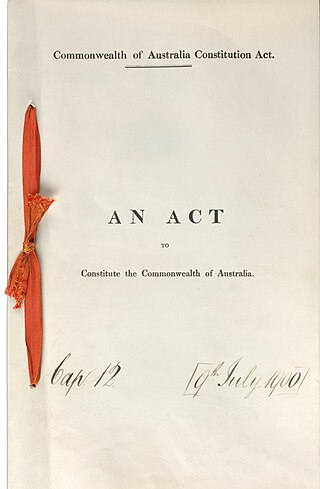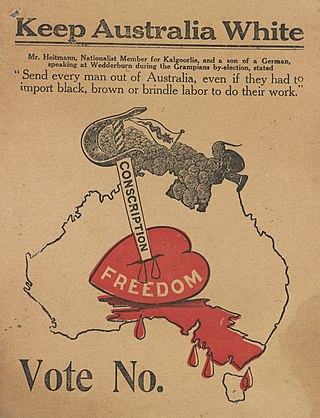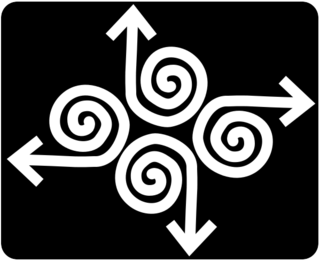See also
- Section 25 of the Constitution of Australia
- Three-Fifths Compromise, similar clause in U.S. Constitution that limited total count of slaves in censuses to 60% of total for purposes of allocating seats in Congress.
Section 127 of the Constitution of Australia was the final section within Chapter VII (dealing with miscellaneous matters) of the Australian Constitution, and excluded Indigenous Australians from population counts for constitutional purposes. [1] It came into effect on 1 January 1901 when the founding states federated into the Commonwealth of Australia, and was repealed effective 10 August 1967 following the 1967 referendum.
Section 127 was included in the Constitution of Australia when it was ratified, and stated that:
The interpretation of section 127 depends on the language used in other parts of the Constitution. Section 24 mandates that each state is entitled to members in the House of Representatives based on a population quota determined from the "latest statistics of the Commonwealth." [3] These statistics arise from the census conducted under the auspices of section 51(xi). [4] The purpose of section 127 was to prevent the inclusion of Aboriginal people in section 24 determinations, and thus to prevent the Indigenous populace from influencing the determination of electoral boundaries by the Australian Electoral Commission. Including Indigenous people in these calculations would alter the distribution of seats between the states to the benefit of states with larger Aboriginal populations (though not to the benefit of the Aboriginal people). [5] Concerns were expressed at the 1897–98 Federation Convention about the distribution of seats and also the possibility of states receiving reduced monies from Commonwealth grants if section 127 were not included. [6]
The language of section 127 does not include the words statistic or census, and consequently the Commonwealth had the power to collect data on the Aboriginal populace, though what was collected lacked quality and comprehensiveness. Its purpose was not to deny information to the government but to give effect to a belief that the indigenous peoples of Australia were separate from the colonists joining together to form a nation. As the British gradually acquired sovereignty over the continent, Aboriginal peoples became British subjects. After Federation, the "Australian governments and the people had no use for the Aborigines." [7] Consideration of the indigenous population was limited to the "problem" of the potential for their number to influence the composition of the House of Representatives, and that was "solved" with section 127. [6] Actual responsibility for the Aboriginal people was left to the individual states (explaining their exclusion from race power); this contributed to the mistaken belief that Aboriginal Australians were considered as 'flora and fauna' until the 1967 referendum on the status of Aboriginals, which was originally the metaphor of pioneer Aboriginal filmmaker Lester Bostock to describe the status of Indigenous Australians, not a statement of fact. [8] Constitutional scholar George Williams has described the race power and section 127 as part of the racism in Australia's constitutional DNA. [9] In the 1960s in the lead-up to the repeal of section 127, racist attitudes towards Aborigines were openly expressed. For example, the Sydney Morning Herald characterised the idea of trying to count the indigenous population as part of the census as both "a mildly entertaining historical oddity" [10] and as "more difficult than rounding up a mob of wild brumbies". [11] [5]
The Holt government held two constitutional referendums on 27 May 1967, and amendments relating to Indigenous Australians were carried overwhelmingly with 90.8% of votes cast in favour. [12] Technically, the referendum passed the bill titled the Constitution Alteration (Aboriginals) 1967 [13] and it became law on 10 August 1967. The referendum altered section 51(xxvi) and allowed the Federal Parliament to legislate for the benefit of the Aboriginal people located in the states (they were already so empowered in the territories by section 122). Additionally, the High Court decision in Kartinyeri v Commonwealth [14] ruled that legislating to the detriment of Indigenous Australians was also within the scope of the power. [15] Section 127 was repealed in its entirety and had the immediate effect of including Aboriginal Australians in population estimates. [16]
The other question put in the referendum, to allow the number of seats in the House of Representatives to be increased without increasing the number of senators, was rejected. [17] Other racially discriminatory parts of the Constitution were left in place. [9]
One immediate consequence of the repeal of section 127 was that full inclusion of Indigenous people in the census became mandatory [5] and the Aboriginal populace was reflected in the allocation of seats in the House of Representatives between the states.

The AustralianHouse of Representatives is the lower house of the bicameral Parliament of Australia, the upper house being the Senate. Its composition and powers are set down in Chapter I of the Constitution of Australia.

The second question of the 1967 Australian referendum of 27 May 1967, called by the Holt government, related to Indigenous Australians. Voters were asked whether to give the Commonwealth Parliament the power to make special laws for Indigenous Australians in states, and whether Indigenous Australians should be included in official population counts for constitutional purposes. The term "the Aboriginal Race" was used in the question.
In Australia, referendums are public votes held on important issues where the electorate may approve or reject a certain proposal. In contemporary usage, polls conducted on non-constitutional issues are known as plebiscites, with the term referendum being reserved solely for votes on constitutional changes, which is legally required to make a change to the Constitution of Australia.
The 1967 Australian referendum occurred on 27 May 1967 under the Holt government. It contained three topics asked about in two questions, regarding the passage of two bills to alter the Australian Constitution.
Section 51(xxvi) of the Constitution of Australia, commonly called "the race power", is the subsection of Section 51 of the Constitution of Australia granting the Australian Commonwealth the power to make special laws for people of any race.

The Freedom Ride of 1965 was a journey undertaken by a group of Aboriginal Australians in a bus across New South Wales, led by Charles Perkins. Its aim was to bring to the attention of the public the extent of racial discrimination in Australia, and it was a significant event in the history of civil rights for Indigenous Australians.

The Census in Australia, officially the Census of Population and Housing, is the national census in Australia that occurs every five years. The census collects key demographic, social and economic data from all people in Australia on census night, including overseas visitors and residents of Australian external territories, only excluding foreign diplomats. The census is the largest and most significant statistical event in Australia and is run by the Australian Bureau of Statistics (ABS). Every person must complete the census, although some personal questions are not compulsory. The penalty for failing to complete the census after being directed to by the Australian Statistician is one federal penalty unit, or A$220. The Australian Bureau of Statistics Act 1975 and Census and Statistics Act 1905 authorise the ABS to collect, store, and share anonymised data.
Section 51(xi) of the Constitution of Australia, a subsection of section 51, grants the Commonwealth the power to make laws for "census and statistics".
Indigenous Australians are people with familial heritage from, and/or recognised membership of, the various ethnic groups living within the territory of present day Australia prior to British colonisation. They consist of two distinct groups, which includes many ethnic groups: the Aboriginal Australians of the mainland and many islands, including Tasmania, and the Torres Strait Islanders of the seas between Queensland and Papua New Guinea, located in Melanesia. The term Aboriginal and Torres Strait Islander peoples or the person's specific cultural group, is often preferred, though the terms First Nations of Australia, First Peoples of Australia and First Australians are also increasingly common; 812,728 people self-identified as being of Aboriginal and/or Torres Strait Islander origin in the 2021 Australian Census, representing 3.2% of the total population of Australia. Of these Indigenous Australians, 91.4% identified as Aboriginal; 4.2% identified as Torres Strait Islander; while 4.4% identified with both groups. Since 1995, the Australian Aboriginal flag and the Torres Strait Islander flag have been official flags of Australia.

The Constitution of Australia is the fundamental law that governs the political structure of Australia. It is a written constitution, that establishes the country as a federation under a constitutional monarchy governed with a parliamentary system. Its eight chapters sets down the structure and powers of the three constituent parts of the federal level of government: the Parliament, the Executive Government and the Judicature.

Racism in Australia comprises negative attitudes and views on race or ethnicity which are held by various people and groups in Australia, and have been reflected in discriminatory laws, practices and actions at various times in the history of Australia against racial or ethnic groups.

The principles of the current Constitution of South Australia, also known as the South Australian Constitution, which includes the rules and procedures for the government of the State of South Australia, are set out in the Constitution Act 1934. Its long title is "An Act to provide for the Constitution of the State; and for other purposes".
Section 25 of the Constitution of Australia is a provision of the Constitution of Australia headed "Provision as to races disqualified from voting" and providing that "For the purposes of the last section, if by the law of any State all persons of any race are disqualified from voting at elections for the more numerous House of the Parliament of the State, then, in reckoning the number of the people of the State or of the Commonwealth, persons of that race resident in that State shall not be counted."
Joyce Caroline ClagueMBE is an Australian political activist and Yaegl elder. Her activism centers on social change for Indigenous Australians. She was influential in instigating the 1967 Constitutional Referendum and in the 1996 native title claim, known as Yaegl #1, which was settled in 2015.

The Federal Council for the Advancement of Aborigines and Torres Strait Islanders (FCAATSI), founded in Adelaide, South Australia, as the Federal Council for Aboriginal Advancement (FCAA) on 16 February 1958, was a civil rights organisation which campaigned for the welfare of Aboriginal Australians and Torres Strait Islanders, and the first national body representing Aboriginal interests. It was influential in lobbying in favour of the 1967 Referendum on Aboriginal Australians. It was renamed to National Aboriginal and Islander Liberation Movement (NAILM) in the early to mid 1970s, before disbanding in 1978.
The "Flora and Fauna Act" myth is a belief often repeated in public debate that Indigenous Australians were classified as fauna by legislation, specifically under a “Flora and Fauna Act”, and managed as such by the Australian and State Governments, and that the legislation and practice was overturned by a change to the Australian Constitution implemented by the 1967 referendum about Aboriginal affairs.
Aboriginal Australian identity, sometimes known as Aboriginality, is the perception of oneself as Aboriginal Australian, or the recognition by others of that identity. Aboriginal Australians are one of two Indigenous Australian groups of peoples, the other being Torres Strait Islanders. There has also been discussion about the use of "Indigenous" vs "Aboriginal", or more specific group names, such as Murri or Noongar (demonyms), Kaurna or Yolngu, based on language, or a clan name. Usually preference of the person(s) in question is used, if known.

The Aboriginal and Torres Strait Islander Voice, also known as the Indigenous Voice to Parliament, the First Nations Voice or simply the Voice, was a proposed Australian federal advisory body to comprise Aboriginal and Torres Strait Islander people, to represent the views of Indigenous communities.
Constitutional recognition of Indigenous Australians refers to various proposals for changes to the Australian Constitution to recognise Indigenous Australians in the document. Various proposals have been suggested to symbolically recognise the special place Indigenous Australians have as the first peoples of Australia, along with substantial changes, such as prohibitions on racial discrimination, the protection of languages and the addition of new institutions. In 2017, the Uluru Statement from the Heart was released by Indigenous leaders, which called for the establishment of an Indigenous Voice to Parliament as their preferred form of recognition. When submitted to a national referendum in 2023 by the Albanese government, the proposal was heavily defeated.
The Council for Aboriginal Rights (CAR) was founded in Melbourne in 1951 in order to improve rights for Indigenous Australians. Although based in the state of Victoria, it was a national organisation and its influence was felt throughout Australia; it was regarded as one of the most important Indigenous rights organisations of the 1950s. It supported causes in several other states, notably Western Australia and Queensland, and the Northern Territory. Some of its members went on to be important figures in other Indigenous rights organisations.